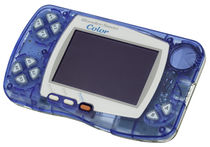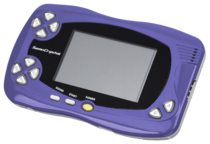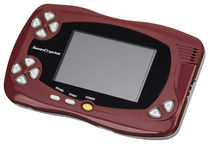WonderSwan emulators
Revision as of 22:17, 23 December 2019 by Bot (talk | contribs) (Changed protection level for "WonderSwan emulators" ([Move=Allow only administrators] (indefinite)))

| |

| |

| |

| |
| Top: The WonderSwan. Middle: The WonderSwan Color. Bottom 2: The SwanCrystal (Blue Violet & Red Wine). | |
| Developer | Bandai |
|---|---|
| Type | Handheld game console |
| Generation | Fifth generation |
| Release date | 1999 (WonderSwan) 2000 (WonderSwan Color) 2002 (Swan Crystal) |
| Discontinued | 2003 |
| Emulated | ✓ |
The WonderSwan, WonderSwan Color and SwanCrystal are the fifth-generation handheld game consoles produced by Bandai in 1999, 2000 and 2002, respectively. It is the brainchild of Game Boy/Color creator, Gunpei Yokoi. There were three versions eventually released: A black-and-white version, a color version, and a Crystal version with an improved screen.
Emulators
| Name | Operating System(s) | Latest Version | Open-Source | Libretro Core | WS | WSC | Active | Recommended |
|---|---|---|---|---|---|---|---|---|
| PC | ||||||||
| Mednafen | Multi-platform | 1.32.1 | ✓ | ✓ | ✓ | ✓ | ✓ | ✓ |
| higan | Multi-platform | v110 | ✓ | ✓ | ✓ | ✓ | ✓ | ✓ |
| BizHawk | Windows | 2.9.1 | ✓ | ✗ | ✓ | ✓ | ✓ | ✓ |
| WSCamp | Windows | 0.21 | ✗ | ✗ | ✓ | ✓ | ✗ | ~ |
| MAME | Multi-platform | 0.265 | ✓ | ✓ | ✓ | ✓ | ✓ | ✗ |
| Cygne | Windows | 2.1a | ✓ | ✗ | ✓ | ✓ | ✗ | ✗ |
| Oswan | Windows | 1.7.3 | ✓ | ✗ | ✓ | ✓ | ✗ | ✗ |
| WonderScott | Windows, Web (Java) | 0.54b | ✗ | ✗ | ✓ | ✓ | ✗ | ✗ |
| Xe | Windows, Linux | 2.16.2 | ✓ | ✗ | ✓ | ✓ | ✗ | ✗ |
| Console | ||||||||
| eSwan | PSP | 0.09 | ✗ | ✗ | ✓ | ✓ | ✗ | ✗ |
Notes
- WSCamp
- A WonderSwan and WS Color emulator written by Toshi. This was the first WonderSwan emulator to feature sound as well as gamepad support, and it has a very high compatibility rate and excellent speed. It was the most accurate WonderSwan emulator at the time in the early 2000's, beating out Cygne and Oswan.
- Cygne
- The first WonderSwan emulator created on the Windows platform, written by DOX and released under the GNU General Public License. It had undergone massive improvements over its original DOS beta form in the early 2000's, including better timing and fixes to the SRAM. Cygne has a high compatibility rate, but lacks in speed and does not offer any sound support. Cygne supports both the original WonderSwan and the WonderSwan Color. However, it was abandoned in 2002.
- Oswan
- Oswan is a WonderSwan/WS Color emulator based on the Cygne source code and authored by David Raingeard. Improvements upon the original Cygne source include the additional of sound support and many speed improvements. Oswan also features the ability to apply several video filters as well as color schemes to add color to WonderSwan Classic titles. It has been abandoned as two variants of it were released in 2007 and 2010.
- WonderScott
- The second WonderSwan/WSC emulator, this WonderSwan emulator written in JavaScript was authored by Julien Frelat (Gollum) and released by the same team that made Boycott Advance. An online web format of WonderScott was also available at its official website, but is probably permanently inaccessible. It was somehow abandoned after its last version, v0.54b, was uploaded near the end of 2001 with poor compatibility.
Features & pages on recommended/available WonderSwan/WS Color emulators:
- BANDAI WONDERSWAN 101: A BEGINNER’S GUIDE (July 6th, 2007 by racketboy; updated June 19th, 2018. Old feature covering early WonderSwan emulation. Oswan and WSCamp were the recommended emulators according to the article. Both are too old by now and not recommended.)
- Wikibooks.org (PSP/Emulation List. 5 old emulators and ports for the PSP.)
- VTEmulation.net (Old list of 3 old, early 2000's recommended emulators. Site no longer maintained.)
- Old-Computers.com (List of 5 old, early 2000's emulators. For reference only.)
- Zophar's Domain (List of downloads for 5 old, early 2000's emulators.)
Debugging
- Mednafen
- This multi-system emulator is said to have great debugging and cheat engine features but, unfortunately, has a CRC check function similar to default MAME. A CRC check analyses a game ROM file for any change to its data and size, so a fan-translator or ROMhacker would have to edit filenames every time for every change, which is incredibly tedious. This is likely the reason why there have not been many hack and fan-translation patches being provided publicly for any game on several systems that are covered by Mednafen such as Wonderswan (this page's topic), Neo Geo and PC Engine/PCE CD. These systems don't tend to have many good alternative emulators, let alone ones with good quality debuggers.
- MAME
- This well-known emulator of thousands of systems also has a normal CRC check algorithm to insure that the ROM file(s) of any supported game or clone, depending on the database/ROMset for a MAME version, match the data integrity and size of the same game/variant in the records. However, this does make it rather prickly for an aspiring ROMhacker. The MAME developers partly wanted this to reduce the nasty incidences of some sellers pawning circuit boards that were actually stuffed with user-made ROMhacks. There are a few ways around that - note that MAME developers still support genuine fan-translators, even for arcade games.
- 1) Try using the HBMAME or MAMEUIFX frontend, which may support loading modified ROMs.
- 2) If you don't zip the set and instead make a folder with the zipname inside your rompath with properly-named loose files inside there, MAME will fuss up, but it will run the game even though the CRCs don't match.
- 3) With the new GEnie build system, it's pretty easy to build a one-game-off version of MAME that builds in seconds on pretty much any worthwhile PC.
- make SUBTARGET=rom_name DRIVERS=src/mame/drivers/whatever.c REGENIE=1
- Oswan
- A very old, broken and dead emulator. But it has a (poorly working) debugger, so making a hack patch on a WS game can be a lot smoother process with this software's tool than Mednafen's.